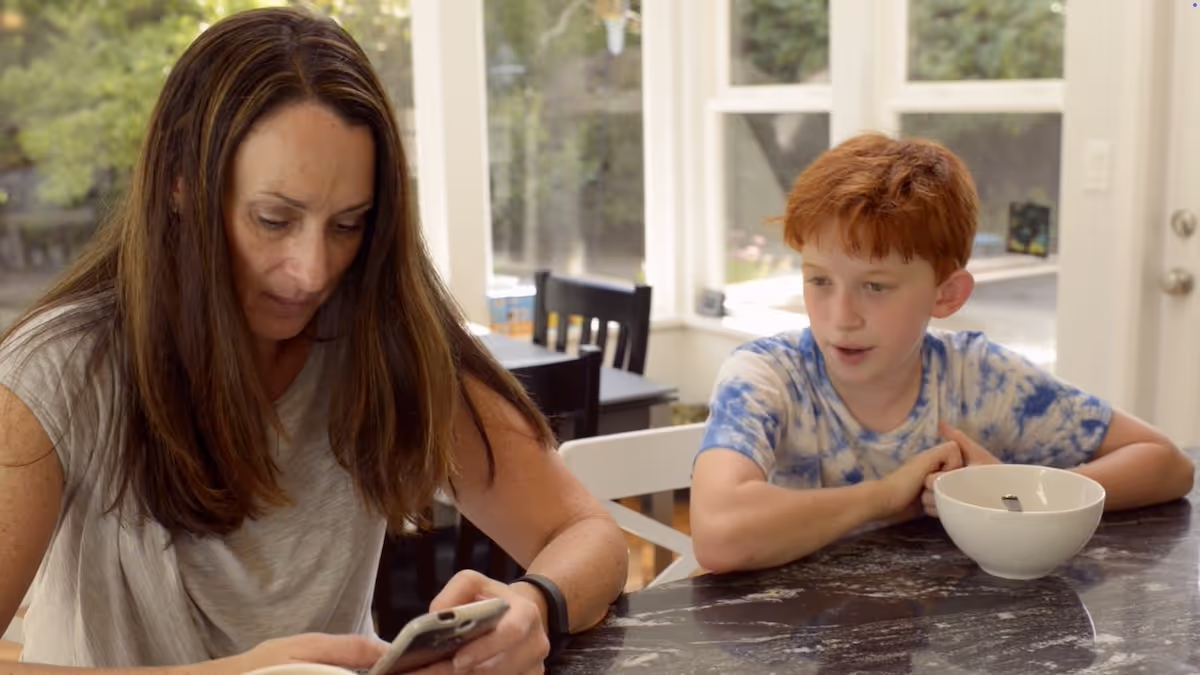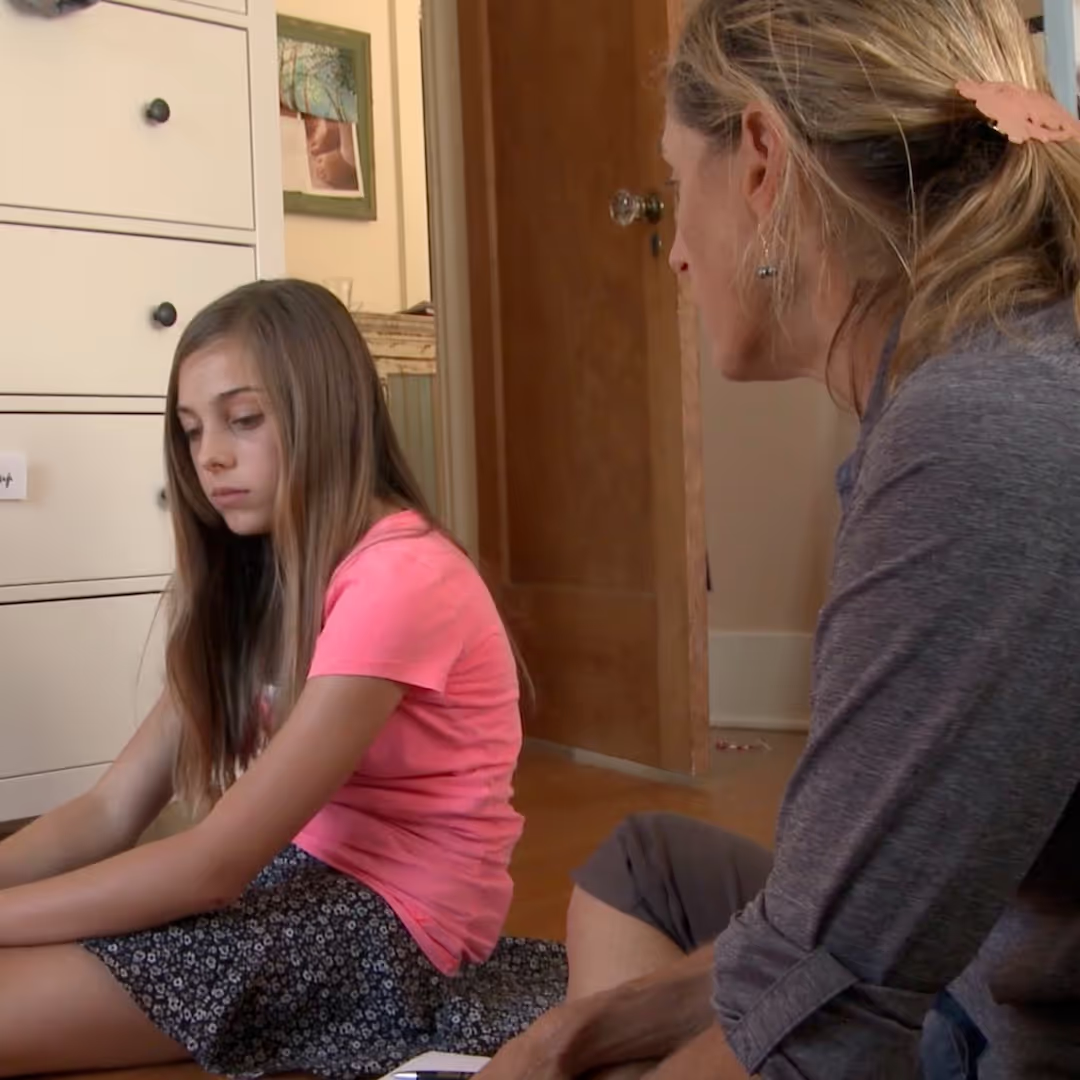


Which hacks decrease undesired screen time? This is the question to ask kids and teens this week. From that discussion, see if they, ideally along with you, will choose to adopt one of these ideas for 24 or even 72 hours. It’s a Hack Challenge—and who doesn’t like a challenge?
I say “ideally along with you” because we are all in this together. But just because we all have challenges around managing screen time does not mean that as parents we should take a hands-off approach. I hear people say about kids that ”They just need to learn by themselves to manage screen time.” The Screenagers team is dedicated to the idea that defining sacred screen-free times in the day is key for helping youth reach their conscious goals and unconscious goals. And, finding hacks to decrease distractions fits into this 100%.
As always we would love to hear from you—what challenge did anyone in your group decide to try? Perhaps you have a different hack that you can share. Please email me directly at delaney@screengagersmove.com. You can use the tab on the left to post this TTT on Facebook, or come to our Facebook page and share with us there. It’s so wonderful to continue to learn from each other, and to be a supportive force when anyone does take on a challenge!
(if your child does not have a phone but uses an iPad or another device with apps they can do this on those devices)
Having all your favorite apps on your home screen can be quite tempting. Try to remove all the tempting apps and replace with just your calendar, your clock, and your calculator. My co-producer, Lisa, removed Facebook and Twitter from her home screen and it has significantly decreased the amount of time she spends on social media.
When it seems a particular app is taking too much of your time, of course the best thing to do is to delete it. Many youth have video game apps (by the way, I was amazed to see how many ads they get on Instagram for additional games). Perhaps your teen will take the challenge to remove a game app for 72 hours?
A recent Pew Research Center survey found that 45% of teens say they are online “near constantly.” Apps like “Freedom” and “Self Control” are aimed at helping people minimizing this. They can block social media, online shopping or anything that distracts you online for whatever amount of time you designate.
On an iPhone, you can set Screen Time which sets a specific amount of time you can use particular apps. Android phones have something on their “Digital Wellbeing” dashboard called App Timers that allow you to set time limits per apps.
According to YouTube, about 70% of the videos people watch on the platform are those that were suggested by the algorithm—and of course, many of these are the ones that start auto-playing (and thus we start “auto-watching”). A simple way to regain control and always stay on purpose is by turning off autoplay. This will prevent another video from automatically loading.
One study found out that the average person receives about 63.5 notifications each day. This interruption is distracting and can lead you down a rabbit hole of time spent on your phone. You’ll be amazed at how much time you save by turning off notifications — limiting them to only those you need.
I have set up my phone so that the only notifications I get are the day of a flight, a car ride, and text—but even for texts I have an app that lets people know that I will not receive their message until I stop my car. People who know me well call me if it’s urgent.
You might have noticed that some websites are cluttered with multitudes of distractions like autoplay videos, pop-up ads, and sidebars that make it difficult to concentrate on one thing.
There are several browser extensions that allow you to remove ads and distractions from your webpages, leaving you a clean page of just text and images. Mercury Reader, a Chrome extension, is a popular one. If the ad blocker does not allow you to read an article, it usually gives you the option to turn it off just for that page. You just look at the top of your screen for a notification.
Try making your phone screen grayscale. The colors on your screen are like candy to your brain. Changing your phone to black and white is less rewarding to your cerebrum and you may then spend less time scrolling. The red notifications, i.e., you have emails waiting, messages to respond to, etc., can cause stress and are difficult to ignore.
We would love for you to share this TTT any way that works for you, whether that’s on social media or via a newsletter. If you want to send it out in your newsletter we just ask that you credit us and link to our website, and let us know at lisa@screenagersmovie.com.
HOST A SCREENING to help spark change.
FIND EVENT LISTINGS
Do you organize professional development in schools? We now have a 6-hour, 3-part training module. Request more information here Professional Development.
Stay in touch with the Screenagers community on Facebook, Twitter and leave comments below.
Learn more about showing our movies in your school or community!
Join Screenagers filmmaker Delaney Ruston MD for our latest Podcast

Learn more about our Screen-Free Sleep campaign at the website!
Our movie made for parents and educators of younger kids
Learn more about showing our movies in your school or community!
Learn more about showing our movies in your school or community!
Join Screenagers filmmaker Delaney Ruston MD for our latest Podcast

Learn more about our Screen-Free Sleep campaign at the website!
Our movie made for parents and educators of younger kids
Join Screenagers filmmaker Delaney Ruston MD for our latest Podcast
As we’re about to celebrate 10 years of Screenagers, we want to hear what’s been most helpful and what you’d like to see next.
Please click here to share your thoughts with us in our community survey. It only takes 5–10 minutes, and everyone who completes it will be entered to win one of five $50 Amazon vouchers.
Which hacks decrease undesired screen time? This is the question to ask kids and teens this week. From that discussion, see if they, ideally along with you, will choose to adopt one of these ideas for 24 or even 72 hours. It’s a Hack Challenge—and who doesn’t like a challenge?
I say “ideally along with you” because we are all in this together. But just because we all have challenges around managing screen time does not mean that as parents we should take a hands-off approach. I hear people say about kids that ”They just need to learn by themselves to manage screen time.” The Screenagers team is dedicated to the idea that defining sacred screen-free times in the day is key for helping youth reach their conscious goals and unconscious goals. And, finding hacks to decrease distractions fits into this 100%.
As always we would love to hear from you—what challenge did anyone in your group decide to try? Perhaps you have a different hack that you can share. Please email me directly at delaney@screengagersmove.com. You can use the tab on the left to post this TTT on Facebook, or come to our Facebook page and share with us there. It’s so wonderful to continue to learn from each other, and to be a supportive force when anyone does take on a challenge!
(if your child does not have a phone but uses an iPad or another device with apps they can do this on those devices)
Having all your favorite apps on your home screen can be quite tempting. Try to remove all the tempting apps and replace with just your calendar, your clock, and your calculator. My co-producer, Lisa, removed Facebook and Twitter from her home screen and it has significantly decreased the amount of time she spends on social media.
When it seems a particular app is taking too much of your time, of course the best thing to do is to delete it. Many youth have video game apps (by the way, I was amazed to see how many ads they get on Instagram for additional games). Perhaps your teen will take the challenge to remove a game app for 72 hours?
A recent Pew Research Center survey found that 45% of teens say they are online “near constantly.” Apps like “Freedom” and “Self Control” are aimed at helping people minimizing this. They can block social media, online shopping or anything that distracts you online for whatever amount of time you designate.
On an iPhone, you can set Screen Time which sets a specific amount of time you can use particular apps. Android phones have something on their “Digital Wellbeing” dashboard called App Timers that allow you to set time limits per apps.
According to YouTube, about 70% of the videos people watch on the platform are those that were suggested by the algorithm—and of course, many of these are the ones that start auto-playing (and thus we start “auto-watching”). A simple way to regain control and always stay on purpose is by turning off autoplay. This will prevent another video from automatically loading.
One study found out that the average person receives about 63.5 notifications each day. This interruption is distracting and can lead you down a rabbit hole of time spent on your phone. You’ll be amazed at how much time you save by turning off notifications — limiting them to only those you need.
I have set up my phone so that the only notifications I get are the day of a flight, a car ride, and text—but even for texts I have an app that lets people know that I will not receive their message until I stop my car. People who know me well call me if it’s urgent.
You might have noticed that some websites are cluttered with multitudes of distractions like autoplay videos, pop-up ads, and sidebars that make it difficult to concentrate on one thing.
There are several browser extensions that allow you to remove ads and distractions from your webpages, leaving you a clean page of just text and images. Mercury Reader, a Chrome extension, is a popular one. If the ad blocker does not allow you to read an article, it usually gives you the option to turn it off just for that page. You just look at the top of your screen for a notification.
Try making your phone screen grayscale. The colors on your screen are like candy to your brain. Changing your phone to black and white is less rewarding to your cerebrum and you may then spend less time scrolling. The red notifications, i.e., you have emails waiting, messages to respond to, etc., can cause stress and are difficult to ignore.
We would love for you to share this TTT any way that works for you, whether that’s on social media or via a newsletter. If you want to send it out in your newsletter we just ask that you credit us and link to our website, and let us know at lisa@screenagersmovie.com.
HOST A SCREENING to help spark change.
FIND EVENT LISTINGS
Do you organize professional development in schools? We now have a 6-hour, 3-part training module. Request more information here Professional Development.
Stay in touch with the Screenagers community on Facebook, Twitter and leave comments below.
Sign up here to receive the weekly Tech Talk Tuesdays newsletter from Screenagers filmmaker Delaney Ruston MD.
We respect your privacy.
Which hacks decrease undesired screen time? This is the question to ask kids and teens this week. From that discussion, see if they, ideally along with you, will choose to adopt one of these ideas for 24 or even 72 hours. It’s a Hack Challenge—and who doesn’t like a challenge?
I say “ideally along with you” because we are all in this together. But just because we all have challenges around managing screen time does not mean that as parents we should take a hands-off approach. I hear people say about kids that ”They just need to learn by themselves to manage screen time.” The Screenagers team is dedicated to the idea that defining sacred screen-free times in the day is key for helping youth reach their conscious goals and unconscious goals. And, finding hacks to decrease distractions fits into this 100%.
As always we would love to hear from you—what challenge did anyone in your group decide to try? Perhaps you have a different hack that you can share. Please email me directly at delaney@screengagersmove.com. You can use the tab on the left to post this TTT on Facebook, or come to our Facebook page and share with us there. It’s so wonderful to continue to learn from each other, and to be a supportive force when anyone does take on a challenge!
(if your child does not have a phone but uses an iPad or another device with apps they can do this on those devices)
Having all your favorite apps on your home screen can be quite tempting. Try to remove all the tempting apps and replace with just your calendar, your clock, and your calculator. My co-producer, Lisa, removed Facebook and Twitter from her home screen and it has significantly decreased the amount of time she spends on social media.
When it seems a particular app is taking too much of your time, of course the best thing to do is to delete it. Many youth have video game apps (by the way, I was amazed to see how many ads they get on Instagram for additional games). Perhaps your teen will take the challenge to remove a game app for 72 hours?
A recent Pew Research Center survey found that 45% of teens say they are online “near constantly.” Apps like “Freedom” and “Self Control” are aimed at helping people minimizing this. They can block social media, online shopping or anything that distracts you online for whatever amount of time you designate.
On an iPhone, you can set Screen Time which sets a specific amount of time you can use particular apps. Android phones have something on their “Digital Wellbeing” dashboard called App Timers that allow you to set time limits per apps.
According to YouTube, about 70% of the videos people watch on the platform are those that were suggested by the algorithm—and of course, many of these are the ones that start auto-playing (and thus we start “auto-watching”). A simple way to regain control and always stay on purpose is by turning off autoplay. This will prevent another video from automatically loading.
One study found out that the average person receives about 63.5 notifications each day. This interruption is distracting and can lead you down a rabbit hole of time spent on your phone. You’ll be amazed at how much time you save by turning off notifications — limiting them to only those you need.
I have set up my phone so that the only notifications I get are the day of a flight, a car ride, and text—but even for texts I have an app that lets people know that I will not receive their message until I stop my car. People who know me well call me if it’s urgent.
You might have noticed that some websites are cluttered with multitudes of distractions like autoplay videos, pop-up ads, and sidebars that make it difficult to concentrate on one thing.
There are several browser extensions that allow you to remove ads and distractions from your webpages, leaving you a clean page of just text and images. Mercury Reader, a Chrome extension, is a popular one. If the ad blocker does not allow you to read an article, it usually gives you the option to turn it off just for that page. You just look at the top of your screen for a notification.
Try making your phone screen grayscale. The colors on your screen are like candy to your brain. Changing your phone to black and white is less rewarding to your cerebrum and you may then spend less time scrolling. The red notifications, i.e., you have emails waiting, messages to respond to, etc., can cause stress and are difficult to ignore.
We would love for you to share this TTT any way that works for you, whether that’s on social media or via a newsletter. If you want to send it out in your newsletter we just ask that you credit us and link to our website, and let us know at lisa@screenagersmovie.com.
HOST A SCREENING to help spark change.
FIND EVENT LISTINGS
Do you organize professional development in schools? We now have a 6-hour, 3-part training module. Request more information here Professional Development.
Stay in touch with the Screenagers community on Facebook, Twitter and leave comments below.

Psychologist Jean Twenge explains how parental controls can support healthier tech use by protecting sleep, limiting late night device access, and reducing kids’ exposure to content they are not developmentally ready to handle. She discusses why third party parental control tools are often more effective and easier to use than built in options, while acknowledging that no system is perfect. Clear boundaries, combined with technology based limits, can reduce ongoing conflict and make screen time rules easier to enforce.
READ MORE >

Parenting in this digital age is full of challenges. I imagine many of you are nodding in agreement. And when we look for advice online, it can feel like a sea of perfect experts with perfect advice: “Just follow these three easy steps and everything will fall into place.” In this week’s blog, I share a story about a moment with my daughter Tessa that did not go quite as planned but ended up teaching us both something important.
READ MORE >for more like this, DR. DELANEY RUSTON'S NEW BOOK, PARENTING IN THE SCREEN AGE, IS THE DEFINITIVE GUIDE FOR TODAY’S PARENTS. WITH INSIGHTS ON SCREEN TIME FROM RESEARCHERS, INPUT FROM KIDS & TEENS, THIS BOOK IS PACKED WITH SOLUTIONS FOR HOW TO START AND SUSTAIN PRODUCTIVE FAMILY TALKS ABOUT TECHNOLOGY AND IT’S IMPACT ON OUR MENTAL WELLBEING.
